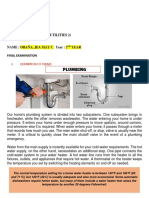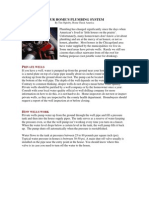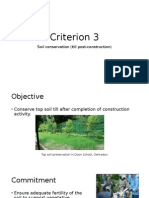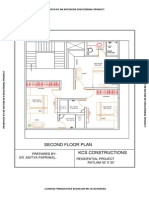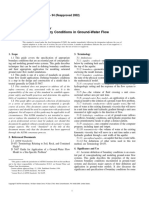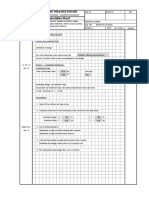Hot Water Supply System Materials
Hot Water Supply System Materials
Uploaded by
VarunPatyalCopyright:
Available Formats
Hot Water Supply System Materials
Hot Water Supply System Materials
Uploaded by
VarunPatyalOriginal Description:
Original Title
Copyright
Available Formats
Share this document
Did you find this document useful?
Is this content inappropriate?
Copyright:
Available Formats
Hot Water Supply System Materials
Hot Water Supply System Materials
Uploaded by
VarunPatyalCopyright:
Available Formats
13-10-2010
1
Most modern western water systems are directly fed
from a municipal water system by a high-pressure pipe,
usually located under the road or street.
Many houses still use a cistern or a well where
convenient water supply is not available; a pump and
pressure tanks are used to maintain system pressure.
Older houses (or houses that need gravity fed cold water)
may also have a cold water tank.
In such a case, drinking water (usually the kitchen tap) is
usually fed directly from the main water supply due to
the risk of contamination in the cold water tank.
COLD WATER SUPPLY SYSTEM Any external water supply is almost always a cold
water supply.
The Cold water supply system may include filter or
water softener appliances and fixtures.
This cold water is then fed to other fixtures, taps, and
appliances that require cold water, such as sinks,
water heaters, faucets, bathtubs, showers, toilets,
etc.
Domestic hot water is provided by means of water
heaters, appliances intended to provide a hot water
supply by heating a volume of water supplied by the Cold
water supply system.
The hot water from these systems is then piped to the
various fixtures, taps, and appliances that require hot
water, such as sinks, bathtubs, showers, washing
machines, etc.
In modern hotels and apartment blocks and service
apartments, centralized storage and distribution systems
are adopted, where other energy sources such as oil, gas,
solar panels, etc., may be used for the generation of hot
water as these options prove more economical and
convenient in heating large volumes of water for storage.
HOT WATER SUPPLY SYSTEM
In old construction, lead plumbing was common. It was
generally eclipsed toward the end of the 1800s by
galvanized iron water pipes which were attached with
threaded pipe fittings.
Copper with soldered fittings became popular around
1950, though it had been used as early as 1900. Plastic
supply pipes have become increasingly common since
about 1970, with a variety of materials and fittings
employed.
Galvanized iron supply pipes are commonly found with
interior diameters from 1/2" to 2", though most domestic
systems won't require any supply pipes larger than 3/4".
(iron is also often used in drain/waste/vent)
MATERIALS
id26179510 pdfMachine by Broadgun Software - a great PDF writer! - a great PDF creator! - http://www.pdfmachine.com http://www.broadgun.com
13-10-2010
2
Pipes have NPT ("National Pipe Thread") standard
threads, which mate with inside threads on elbows,
couplers and other fittings.
Galvanized iron (often known simply as "galv" or
"iron" in the plumbing trade) is relatively expensive,
difficult to work with (due to weight and requirement
of a pipe threader), and suffers from a tendency to
obstruction due to mineral deposits forming on the
inside of the pipe.
It remains common for repair of existing "galv"
systems and to satisfy building code non-
combustiblity requirements typically found in hotels,
apartment buildings and other commercial
applications. It is also extremely durable.
Generally, copper tubes are soldered directly into copper or
brass fittings, although compression or flare fittings are
commonly used by residential plumbers (Note: the annealing
quality of the pipe or tube can affect the performance of
compression fittings and their ability to "make-up" during
installation).
Formerly, concerns with copper supply tubes included the
lead used in the (50%tin-50%lead)solder at joints. Some
studies have shown significant "leaching" of the lead into the
potable water stream, particularly after long periods of low
usage, followed by peak demand periods.
In hard water applications, shortly after installation, the
interior of the pipes will be coated with the deposited
minerals, which had been dissolved in the water and
therefore the vast majority of exposed lead would be
prevented from entering the potable water. Building code
requirements often require lead-free solder for copper and
brass. Building Codes throughout the U.S. require the use of
virtually "lead-free" (<.2% lead) solder or filler metals.
Plastic pipe is in wide use for domestic water
supply, waste or vent pipe, polyvinyl chloride
(PVC), chlorinated polyvinyl chloride (CPVC),
polypropylene (PP)
PVC/CPVC - rigid plastic pipes similar to PVC
drain pipes but with thicker walls to deal with
municipal water pressure, introduced around
1970.
PVC should be used for cold water only, or
venting, CPVC should be used for hot and cold.
Connections are made with primers and solvent
cements, consult pipe and fitting manufacturer
for best combination.
13-10-2010
3
9
Water Pipes and Fittings
Plastic pipe is used in many plumbing applications because
it's relatively inexpensive, easy to install and impervious to
corrosion. In some locations, plastic pipe is not allowed by
codes for supply piping.
Rigid pipe may be PVC (polyvinyl chloride) for cold water or
DWV plumbing, CPVC (chlorinated polyvinyl chloride) for hot
and cold water and ABS (acrylonitrile-butadiene-styrene) for
DWV piping. Flexible plastic tubing is made from PB
(polybutylene) and PE (polyethylene). Plastic pipe is rated for
the pressure it can handle; this rating is stamped on the
outside of the pipe.
10
Rigid copper pipe is widely preferred for water supply piping.
It's sturdy and durable, resists mineral buildup and can handle
both cold and hot water. Hard supply pipe is sold in three
thicknesses: M (thin wall), L (medium wall) and K (thick wall).
Most above-ground plumbing is Type M.
Soft copper supply pipe is more expensive than hard copper
pipe but is flexible enough to be routed without as many
fittings. Type L (medium wall) is more commonly used than
Type M (thick wall) for above-ground applications. Copper
pipe may be joined with permanently soldered fittings or
flare/compression fittings that can be disassembled.
11
Galvanized iron pipe and fittings were standard for water
supply plumbing before 1960 and are still common. The
galvanized zinc coating on the outside of this pipe resists
rust and corrosion but insides of pipes clog up with
mineral deposits and corrode over time. Water-tight
connections are made with threaded fittings. Larger-
diameter galvanized iron pipe is used for vent plumbing
in some houses.
To prevent corrosion from electrolysis that occurs when
two dissimilar metals are joined together, a dielectric
union should be used anywhere copper is connected to
an iron pipe.
Cast iron pipe is a strong, durable material used for
drain, waste and vent (DWV) plumbing. Two types are
common: the older "hub" or "bell-and-spigot" type that
is joined together with lead and oakum and newer "no-
hub" or "hubless" fittings that are connected with special
rubber gaskets and stainless steel band clamps.
12
House Plumbing
A house actually has
several plumbing systems.
Water supply piping brings
water to the house and
distributes it to fixtures and
appliances, including
outdoor sprinklers and
irrigation.
Drain and waste plumbing
disposes of used water and
waste.
Vent piping exhausts sewer
gasses and provides proper
pressure for the drainpipes.
And some homes even
have pipe systems that
serve specialty needs-
swimming pool plumbing
and built-in vacuum piping,
13-10-2010
4
Water Valves and Hose Bibb's A hose bibb, an outdoor faucet, is threaded to receive a
garden hose. The type with a wall-attachment flange is called
a sillcock.
The globe valve serves as a shutoff valve that also controls
water pressure. Unlike the gate valve, this shutoff valve can
be used partially open. Angled varieties are also available.
Water meter &water shutoff valve
Water travels under pressure through a system of
pipes to our homes.
The water company uses a water meter to measure
how much water you use (unless your water use isn't
tracked). This meter is often buried in a housing with
a removable lid, located in front of the house, near
the street. In cold-winter areas, it may be inside the
basement or crawl space-often placed where the
meter reader can check it monthly without
disturbing you. The water company delivers water to
the meter through a large pipe called a main, which
often parallels the street.
A gate valve, used as main shutoff valve, is designed to be
used either completely open or closed. As you open the valve,
a tapered wedge retracts from the water channel into valve's
body, allowing water to flow. When closed, the wedge creates
a seal. Other valves control the flow of water through parts of
your supply system. A valve near the house may shut off all
water indoors; another may control all garden water.
A main shutoff valve is often located on each side of the water
meter. The one on the street side is the water company's
valve-the one used to shut off the system when they want to
work on or change your meter. The other one controls water
that flows to your house. This is your main shutoff; turning it
completely clockwise will stop all water flowing through your
water supply system-both indoors and outdoors.
You might also like
- PlumbingDocument19 pagesPlumbingJefford C. ObañaNo ratings yet
- Plumbing Fixtures and FittingsDocument22 pagesPlumbing Fixtures and FittingsAnonymous 4iYnEhFO80% (5)
- Visual Design Elements and PrinciplesDocument7 pagesVisual Design Elements and PrinciplesVarunPatyalNo ratings yet
- Hydraulics WEIRSDocument7 pagesHydraulics WEIRSJohn Vincent Pineda100% (1)
- Plumbing System: Prepared By: Group 7Document56 pagesPlumbing System: Prepared By: Group 7Glenn Midel Delos SantosNo ratings yet
- Water Supply ArchitectureDocument8 pagesWater Supply ArchitectureRHYME KIDSNo ratings yet
- Types of Pipes and Their UsesDocument8 pagesTypes of Pipes and Their UsesMENDOZA Marie GenielleNo ratings yet
- Cold Water Distribution - MEN516Document45 pagesCold Water Distribution - MEN516charbelNo ratings yet
- PlumbingDocument44 pagesPlumbingHilal Tampi Datu BadrodenNo ratings yet
- NewDocument97 pagesNewĢI ĢINo ratings yet
- Plumbing Materials and Various ToolsDocument8 pagesPlumbing Materials and Various ToolsJayson G. GunioNo ratings yet
- Plumbing Materials, Fittings, & Fixtures - LITA (2D)Document11 pagesPlumbing Materials, Fittings, & Fixtures - LITA (2D)Vincent LitaNo ratings yet
- Lecture 8 Plumbing MaterialsDocument49 pagesLecture 8 Plumbing Materialspepito manalotoNo ratings yet
- Unit II Plumbing ServicesDocument71 pagesUnit II Plumbing Services17002c237jyothisaiNo ratings yet
- Plumbing, Home Inspection Course and Exam - North America, CanadaDocument56 pagesPlumbing, Home Inspection Course and Exam - North America, CanadaAli Noroozi100% (4)
- ملزمة خدمات مبانيDocument51 pagesملزمة خدمات مبانيغفران عبد الرسول حسن خميطNo ratings yet
- Water Distribution SystemDocument6 pagesWater Distribution SystemGDELA CRUZ, PRINCEZKHA ANN D.No ratings yet
- Tle q4 M1to3Document12 pagesTle q4 M1to3Syrart's Digitally Art'sNo ratings yet
- Module Plumbing 13Document16 pagesModule Plumbing 13markroquero235No ratings yet
- Notes (Civil Tech)Document12 pagesNotes (Civil Tech)John Rowell S. MendozaNo ratings yet
- Plumbing and Plumbing MaterialsDocument115 pagesPlumbing and Plumbing MaterialsJoseph Aeron SarmientoNo ratings yet
- Notes in TleDocument110 pagesNotes in TlejhezelfrancostNo ratings yet
- Plumbing For BuildingsDocument24 pagesPlumbing For BuildingsMorshed Bin Alam FervvezNo ratings yet
- Plumbing ModuleDocument14 pagesPlumbing ModuleJoseph CoralesNo ratings yet
- Case Study On The Application of A Proper PlumbingDocument25 pagesCase Study On The Application of A Proper PlumbingJeremie SaragaNo ratings yet
- Water Supply and Sanitary Management: J.Sudharsun MAB1850001Document17 pagesWater Supply and Sanitary Management: J.Sudharsun MAB1850001Sudhar SunNo ratings yet
- Grade 7 Hand Outs A.Y 2023 2024Document39 pagesGrade 7 Hand Outs A.Y 2023 2024Ryan Joseph BalmacedaNo ratings yet
- GROUP 3 Solid WasteDocument20 pagesGROUP 3 Solid WastePhilip jhon T. IcaroNo ratings yet
- Topic 3 ReviewerDocument5 pagesTopic 3 ReviewerZera PotNo ratings yet
- BS NotesDocument34 pagesBS NotesShreyas SuryavanshiNo ratings yet
- Module 25 SAHITA Plumbing Pipes DrainsDocument15 pagesModule 25 SAHITA Plumbing Pipes Drainszolalkk50% (2)
- Draft Sanitary and Plumbing Layout and DetailsDocument11 pagesDraft Sanitary and Plumbing Layout and DetailsRonelyn Tuliao Bueno Daniel100% (1)
- Your Home'S Plumbing System: Rivate WellsDocument8 pagesYour Home'S Plumbing System: Rivate WellsGatot HardiyantoNo ratings yet
- Presentation Plumbing On Process ABUBEKER ABRARDocument27 pagesPresentation Plumbing On Process ABUBEKER ABRARnatiz addisNo ratings yet
- Reviewer in Utils 2Document14 pagesReviewer in Utils 2Kobe Alcantara ReyesNo ratings yet
- QualifiedDocument25 pagesQualifiednatiz addisNo ratings yet
- Plumbing Materials, Fittings, FixturesDocument21 pagesPlumbing Materials, Fittings, FixturesRayan Ahmad BarodiNo ratings yet
- Plumbing Materials and Fixtures ReportingDocument125 pagesPlumbing Materials and Fixtures ReportingChristine De JesusNo ratings yet
- Chapter 20 Plumbing Plans PDFDocument24 pagesChapter 20 Plumbing Plans PDFmimahmoud67% (3)
- Plumbing: Prepared By: Ma. Sofia M. Gutierrez Beed 2-FDocument14 pagesPlumbing: Prepared By: Ma. Sofia M. Gutierrez Beed 2-FSOFIA GUTIERREZNo ratings yet
- Cold and Hot Water SupplyDocument21 pagesCold and Hot Water SupplySylvia MasakiNo ratings yet
- PlumbingDocument5 pagesPlumbingmico alilayaNo ratings yet
- Piping and Plumbing Fittings PDFDocument5 pagesPiping and Plumbing Fittings PDFmichol201450% (4)
- Building Utilities - PlumbingDocument22 pagesBuilding Utilities - PlumbingJonas FloresNo ratings yet
- Cold Water Supply System (Part 2) : Subject: Building Services 1 (BLD 60403)Document49 pagesCold Water Supply System (Part 2) : Subject: Building Services 1 (BLD 60403)Mahmoud I. MahmoudNo ratings yet
- CTM7 3&4 PlumbingDocument100 pagesCTM7 3&4 PlumbingJoebelle SenadorNo ratings yet
- Building Utilities - PlumbingDocument22 pagesBuilding Utilities - PlumbingJonas FloresNo ratings yet
- 2.the Plumbing PracticeDocument52 pages2.the Plumbing PracticeAnjalySinha100% (2)
- MetersDocument22 pagesMetersSubhashish .DeyNo ratings yet
- Lecture 2 BD2 LecDocument4 pagesLecture 2 BD2 LecGian MalabananNo ratings yet
- Drainage PipesDocument13 pagesDrainage PipesnikihilNo ratings yet
- Materials Fittings and FixturesDocument60 pagesMaterials Fittings and Fixtureslanie mondiaNo ratings yet
- Cold Water InstallationDocument13 pagesCold Water InstallationScribdTranslationsNo ratings yet
- Share 12.4 and 12.5 ReportDocument26 pagesShare 12.4 and 12.5 ReportMichael Dominique Granada IINo ratings yet
- Blue Bold Name Minimalist Professional A4 ResumeDocument4 pagesBlue Bold Name Minimalist Professional A4 ResumeRenz SantiagoNo ratings yet
- p2 Plumbing PPT WorkshopDocument17 pagesp2 Plumbing PPT Workshopgetachew asefaNo ratings yet
- Ecm 216 Building Services Bab 3.2 Water Supply PDFDocument6 pagesEcm 216 Building Services Bab 3.2 Water Supply PDFAZUAN BIN AHMAD FAUZI100% (8)
- A Fitting: Pipe Tubing FluidDocument7 pagesA Fitting: Pipe Tubing FluidAliNo ratings yet
- Week Two: Plumbing. Technologist'S Name: Mr. Nyaga. AbstractDocument6 pagesWeek Two: Plumbing. Technologist'S Name: Mr. Nyaga. AbstractEVANS KIPNGETICHNo ratings yet
- Plumbing FittingsDocument9 pagesPlumbing FittingsRenceNo ratings yet
- Plumbing Materials, Fittings and FixturesDocument6 pagesPlumbing Materials, Fittings and FixturesJohn michael Del rosarioNo ratings yet
- GRIHA Criterion 3Document10 pagesGRIHA Criterion 3VarunPatyalNo ratings yet
- ArchitectsDocument10 pagesArchitectsVarunPatyalNo ratings yet
- FCBCVBDocument3 pagesFCBCVBVarunPatyalNo ratings yet
- Block B: Classroom Classroom ClassroomDocument1 pageBlock B: Classroom Classroom ClassroomVarunPatyalNo ratings yet
- Block B: Classroom Classroom Classroom Classroom ClassroomDocument1 pageBlock B: Classroom Classroom Classroom Classroom ClassroomVarunPatyalNo ratings yet
- First Floor Plan Kcs Constructions: Residential Project RATLAM 30' X 30' Prepared By: Er. Aditya PapriwalDocument1 pageFirst Floor Plan Kcs Constructions: Residential Project RATLAM 30' X 30' Prepared By: Er. Aditya PapriwalVarunPatyalNo ratings yet
- Second Floor Plan Kcs Constructions: Residential Project RATLAM 30' X 30' Prepared By: Er. Aditya PapriwalDocument1 pageSecond Floor Plan Kcs Constructions: Residential Project RATLAM 30' X 30' Prepared By: Er. Aditya PapriwalVarunPatyalNo ratings yet
- Ground Floor Plan: Shop 13' 8'' X14' 11" Drawing Room 15'1" X13'9"Document1 pageGround Floor Plan: Shop 13' 8'' X14' 11" Drawing Room 15'1" X13'9"VarunPatyalNo ratings yet
- Building ServicesDocument49 pagesBuilding ServicesVarunPatyal67% (3)
- Reason and Professional EthicsDocument309 pagesReason and Professional EthicsVarunPatyal100% (2)
- SdfsfsDocument17 pagesSdfsfsVarunPatyalNo ratings yet
- Dadasaheb Phalke AwardDocument1 pageDadasaheb Phalke AwardVarunPatyalNo ratings yet
- Vernacular Architecture of ScotlandDocument11 pagesVernacular Architecture of ScotlandVarunPatyal100% (1)
- Dadasaheb Phalke AwardDocument2 pagesDadasaheb Phalke AwardVarunPatyalNo ratings yet
- By: Deepak Kumar Singh Saumya Kohli Sushant School of Art and ArchitectureDocument2 pagesBy: Deepak Kumar Singh Saumya Kohli Sushant School of Art and ArchitectureVarunPatyalNo ratings yet
- Application Form For Name ChangeDocument4 pagesApplication Form For Name ChangeVarunPatyalNo ratings yet
- Commercial Brief For StudentsDocument2 pagesCommercial Brief For StudentsVarunPatyalNo ratings yet
- 2 Building Services N.I.T. Hamirpur: Department of Architecture Ar. Anshu Dadwal Varun Patyal 12605 B.Arch. 2Nd SemDocument1 page2 Building Services N.I.T. Hamirpur: Department of Architecture Ar. Anshu Dadwal Varun Patyal 12605 B.Arch. 2Nd SemVarunPatyalNo ratings yet
- 3 Pond Design and LayoutDocument59 pages3 Pond Design and Layoutditano.mm68No ratings yet
- 24 GeologyDocument26 pages24 GeologyMalsawmkima Maski-a67% (3)
- 2023-24 - Geography - 10-Notes Water - ResourcesDocument4 pages2023-24 - Geography - 10-Notes Water - ResourcesZoha AzizNo ratings yet
- GNR 618 - Lecture.0 (09 Jan 2024)Document11 pagesGNR 618 - Lecture.0 (09 Jan 2024)Aryank BanothNo ratings yet
- Comparison of WBNM and HEC-HMS For Runoff Hydrograph Prediction in A Small Urban CatchmentDocument17 pagesComparison of WBNM and HEC-HMS For Runoff Hydrograph Prediction in A Small Urban CatchmentFrancisco Thibério Pinheiro LeitãoNo ratings yet
- Drainage Patterns and Their CharacteristicsDocument26 pagesDrainage Patterns and Their Characteristicsfilza zakiNo ratings yet
- Sinking CitiesDocument12 pagesSinking Citieskhawaja AliNo ratings yet
- Scouring Around Bridge Pier: Chandrakant Vinayakrao PatilDocument20 pagesScouring Around Bridge Pier: Chandrakant Vinayakrao Patilbhargav75No ratings yet
- Carrying Capacity & Assimilative CapacityDocument44 pagesCarrying Capacity & Assimilative CapacityAusie AmaliaNo ratings yet
- AnuppurDocument16 pagesAnuppurshivseenu100% (1)
- 4EX WaterDocument28 pages4EX WaterMohamad GharibNo ratings yet
- CAPS BessatDocument239 pagesCAPS BessatJoefel BessatNo ratings yet
- MAX H20 Desalter BrochureDocument2 pagesMAX H20 Desalter BrochureAnonymous fj9ypF83No ratings yet
- Testing Water Quality LabDocument2 pagesTesting Water Quality Labapi-290100812No ratings yet
- Defining Boundary Conditions in Ground-Water Flow Modeling: Standard Guide ForDocument4 pagesDefining Boundary Conditions in Ground-Water Flow Modeling: Standard Guide ForGeotecnia PerúNo ratings yet
- The Earth SpheresDocument22 pagesThe Earth Spheresodette jeane rubinNo ratings yet
- Calculation Sheet: Perunding Nusajasa SDN BHDDocument7 pagesCalculation Sheet: Perunding Nusajasa SDN BHDSarahLukakuNo ratings yet
- Cover+High and DryDocument12 pagesCover+High and DryAlbuquerque JournalNo ratings yet
- Garbin DumagandarDocument17 pagesGarbin Dumagandarmonserate90No ratings yet
- Reservoir / Storage Routing Example 1: Storage CalculationDocument15 pagesReservoir / Storage Routing Example 1: Storage Calculationtesh100% (3)
- CV Fip 74Document2 pagesCV Fip 74Fakhmi ImanuddinNo ratings yet
- Generation/Erode: Mettur Dam Power HouseDocument20 pagesGeneration/Erode: Mettur Dam Power Housesrivaas131985No ratings yet
- SST T S DiagramDocument15 pagesSST T S Diagramazizul fazalNo ratings yet
- SEWERAGE - Introduction, Design ConsiderationDocument49 pagesSEWERAGE - Introduction, Design ConsiderationMohd RafiqNo ratings yet
- Final Report Group 5reviewDocument31 pagesFinal Report Group 5reviewBibechana KhadkaNo ratings yet
- Biophysical ProfileDocument42 pagesBiophysical ProfilerogonpouNo ratings yet
- LiDar Map Imus RIverDocument258 pagesLiDar Map Imus RIverZabdiel Jairus AustriaNo ratings yet
- 7-Diversion Head WorksDocument23 pages7-Diversion Head Workswajid malikNo ratings yet
- Many at Risk of Contracting Diseases From The Poorly Managed Wastewater of 26 Million FilipinosDocument2 pagesMany at Risk of Contracting Diseases From The Poorly Managed Wastewater of 26 Million FilipinosrerereNo ratings yet
